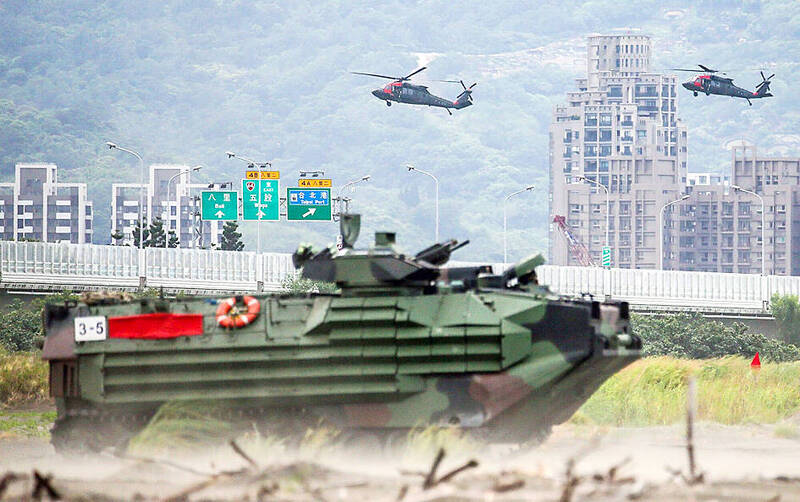《TAIPEI TIMES》 Han Kuang drills to switch focus

Two UH-60M Black Hawk helicopters and an assault amphibious vehicle on a beach in New Taipei City’s Bali District are pictured during the Han Kuang military exercises on July 27 last year. Photo: I-Hwa Cheng, Bloomberg
ADAPTING: The annual live-fire exercises would include night-time drills and test how units would perform after losing contact with central command
/ Staff writer, with CNA and Reuters
The upcoming live-fire segment of Taiwan’s annual Han Kuang military exercises would focus on testing troops’ response to a decentralized command structure, the updated rules of engagement and unremitting operational scenarios, a military source said yesterday.
The Han Kuang exercises, the nation’s largest military drills, are held annually in two stages. The 40th edition this year began with the tabletop war games phase from April 19 to 26.
The live-fire exercises are scheduled to take place from July 22 to 26, the Ministry of National Defense has said.
This year’s live-fire exercises would prioritize testing the ability of troops to fend off an unremitting Chinese invasion, how prepared troops are to launch counterattacks based on their own judgement, and their ability to follow the updated rules of engagement, a military source said, speaking on condition of anonymity.
In previous years, the five-day live-fire portion of the exercises was primarily conducted during the day, but this year, the drills would also be held at night, as “the enemy could strike at any time of the day,” the source said.
The exercises would include a decentralized command structure, meaning units would have to make their own judgement calls after losing contact with central command, they said.
Each unit should follow the updated rules of engagement when encountering enemy troops, even when they are unable to contact central command, the source added.
Revised rules of engagement were released last year, amid repeated incursions into Taiwan’s air defense identification zone by Chinese warplanes, drones and balloons.
The rules instruct troops on which scenarios they are authorized to use weapons and ammunition to launch counterattacks, the source said.
Unlike in previous editions, there are to be fewer live-fire exercises open to the media.
The military used to give media access to parts of the exercises and invited senior government officials, including the president, to oversee them. The purpose was to keep the public informed about the latest military developments and to assure them that their troops are capable of defending the nation.
That practice serves little practical purpose in terms of preparing for war, the source said.
As a test of the armed forces’ emergency response capabilities, the military would also simulate several scenarios that could occur if a cross-strait war were to break out without prior warning, they added.
This year, the exercises would be as close as possible to actual combat given the rapidly rising “enemy threat” from China, said a senior official, speaking on condition of anonymity.
China has been staging regular exercises around Taiwan.
“In recent years, the enemy threat has changed rapidly,” the official said. “Our defense combat plan must also be continuously revised on a rolling basis, and the urgency of comprehensive combat training is becoming more important.”
Things might go wrong in the drills, such as vehicle breakdowns, which would be fine, as “these are problems that might be faced in actual combat,” they said.
The exercises would be a continuous experience, as “war does not distinguish between night and day,” the official said.
The defense ministry in April said the war games would practice “kill” zones at sea to break a blockade and simulate a scenario where China suddenly turns one of its regular drills around Taiwan into an attack.
“Only with real-time, on-the-ground verification can we truly understand the capabilities and limitations of our troops,” the official said.
China held two days of its own war games around Taiwan shortly after President William Lai (賴清德) took office on May 20, saying it was “punishment” for his inauguration speech.
China has also been using “gray zone” warfare against Taiwan, which means using irregular tactics to exhaust a foe by keeping them continually on alert without resorting to open combat.
This has included sending balloons over Taiwan and almost daily air force missions in the skies near Taiwan.
The official declined to comment on which parts of the war games Lai would attend or whether there would be US observers.
新聞來源:TAIPEI TIMES
















